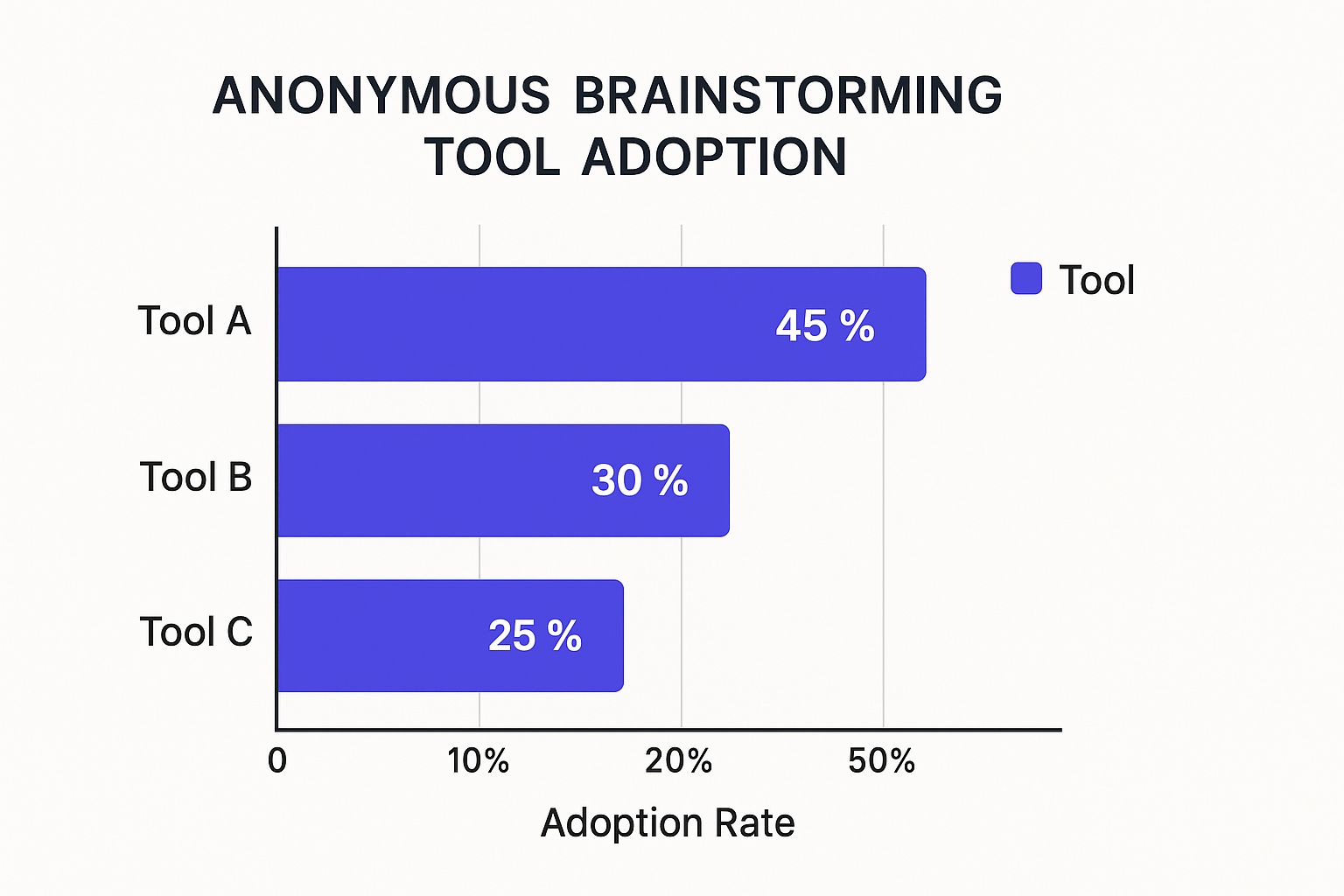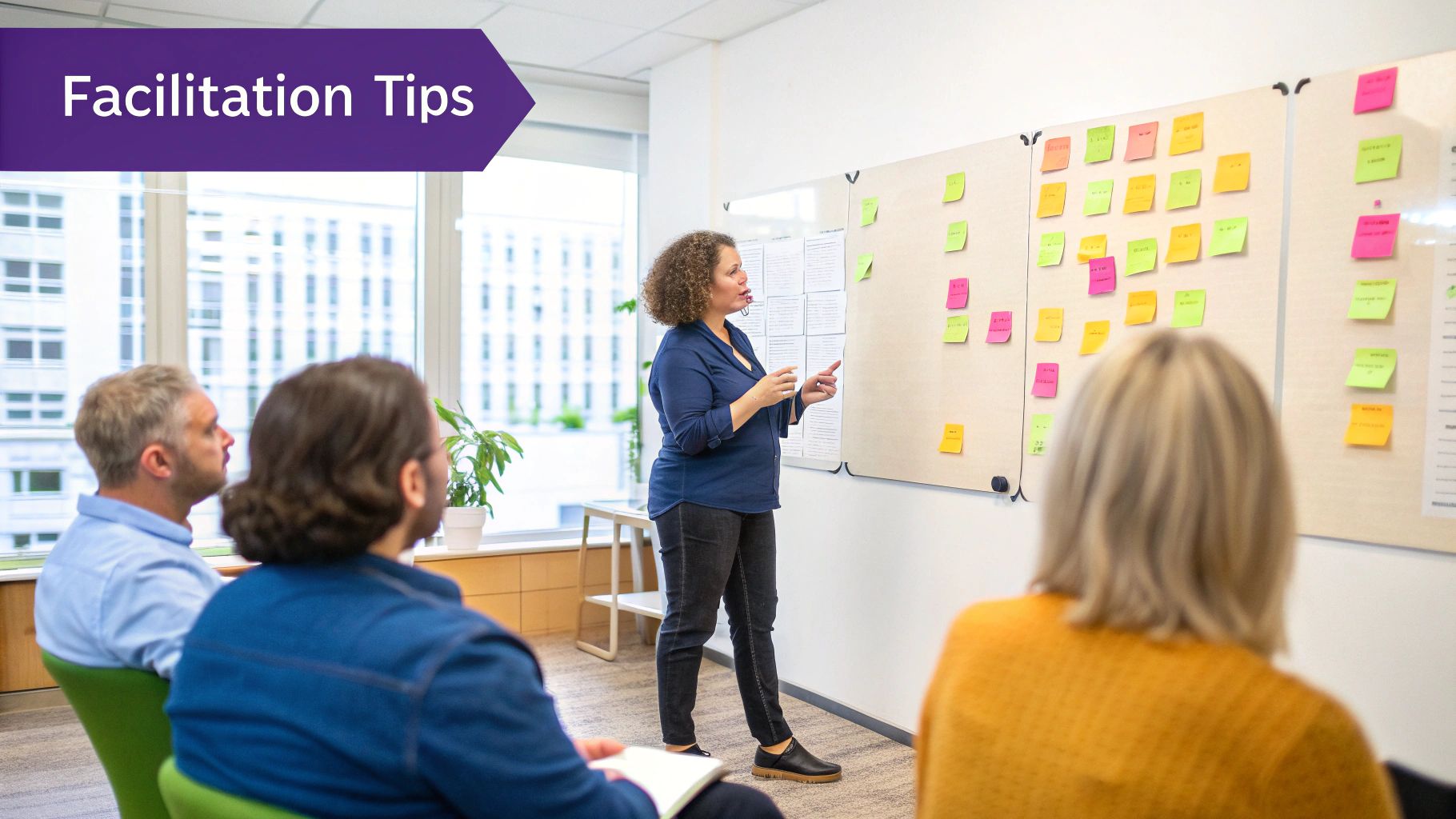Picture a suggestion box where every single idea gets a fair shake, but nobody knows who submitted it. That’s the heart of anonymous brainstorming. It’s a simple but powerful way to untangle ideas from egos, creating a space where creativity can run wild without fear. The goal is to judge ideas purely on their own merit, not on who came up with them.
What Is Anonymous Brainstorming

Essentially, anonymous brainstorming is a structured way to gather ideas where every contribution is made without a name attached. Think of it as a silent, collaborative writing session where the focus is on filling the page with solutions, not on who gets the credit. This one small tweak—removing names—completely changes the feel of a typical group brainstorm.
Suddenly, it’s not just the same few dominant voices steering the conversation. A space opens up where everyone feels comfortable participating. The fear of saying something “silly” or “off-the-wall” fades away because there’s no personal reputation on the line. It’s this psychological safety that unlocks a much higher quantity and quality of ideas.
The Power of Separating the Idea from the Person
Let’s be honest, traditional brainstorming can sometimes feel like a performance. People often hold back on sharing a raw or unconventional idea, worried about how it might make them look. That kind of self-censorship quietly kills innovation.
Anonymous brainstorming tears down that barrier. It gives everyone a protective shield. When your name isn’t tied to an idea, you’re far more willing to share thoughts that are truly outside the box. The focus naturally shifts from who is talking to what is being said.
Anonymity creates a unique environment where the merit of an idea becomes the sole criterion for its evaluation. It empowers team members to contribute authentically, free from the social pressures and hierarchies that often stifle creative thinking in conventional settings.
This approach is a natural antidote to some of the most common brainstorming problems:
- Groupthink: When no one knows who said what, people are less likely to just go along with the first or most popular idea. They submit their thoughts independently, which means you get a much broader range of perspectives.
- Evaluation Apprehension: The fear of being judged by managers or peers is a huge reason people stay quiet. Anonymity gets rid of that fear, encouraging more creative risk-taking.
- Introvert-Extrovert Imbalance: In a standard meeting, extroverts can easily dominate the floor. Anonymity gives introverts and more reserved team members an equal opportunity to have their great ideas heard and considered.
How It Works in Practice
Getting started with anonymous brainstorming is pretty straightforward. A facilitator poses a problem or a question, and the team members submit their ideas using a tool that keeps their identities hidden. For example, a platform like Bulby is a tool designed specifically for anonymous brainstorming—when people submit ideas, it’s always anonymous. This makes the whole process smooth and frictionless.
This method is a game-changer for remote and hybrid teams. In fact, recent research shows that anonymity helps people think beyond their usual limits without worrying about criticism. As highlighted in a 2023 Westpac article on surprising research findings, this is especially powerful for distributed teams, allowing everyone from introverts and juniors to optimists and even the resident pessimist to contribute on a truly level playing field.
At the end of the day, by disconnecting the ego from the idea, anonymous brainstorming builds a more inclusive, honest, and productive creative culture. It isn’t just about getting more ideas; it’s about getting better and more authentic ideas from every single person on the team.
The Real Benefits for Your Team

Adopting anonymous brainstorming offers some powerful advantages that go way beyond just getting a longer list of ideas. The biggest win is creating a deep sense of psychological safety, which is the bedrock of any team that truly performs at a high level. Think of it as an invisible shield that lets every single person contribute without hesitation.
When you remove the fear of being judged, people are far more likely to share those “out there” ideas, risky thoughts, or half-baked concepts that often spark a real breakthrough. This safety net encourages the kind of vulnerability that fuels genuine innovation, shifting the team’s focus from protecting egos to solving problems together.
Cultivating Genuine Diversity of Thought
Real diversity isn’t just about having different people on the team; it’s about making sure their ideas are actually heard. This is where anonymous brainstorming shines. It levels the playing field, giving every perspective an equal shot.
In a typical meeting, quieter team members, introverts, or junior staff often hold back. They worry about interrupting a senior colleague or sounding inexperienced. Anonymity completely dismantles those social hurdles. It gives them the same platform as everyone else to share their insights without having to fight for the spotlight, unlocking the rich diversity of thought you need to crack complex challenges. You can also explore other effective brainstorming techniques to complement this and engage different personalities.
When critiques are directed at the idea itself—not the person who suggested it—discussions become radically more objective. The conversation moves away from defending personal territory and toward collaboratively refining the best possible solution for the team.
Improving the Quality of Feedback
One of the most immediate perks of anonymous brainstorming is how much better the feedback becomes. When you detach names from suggestions, the entire feedback loop gets cleaner and far more constructive.
Instead of softening criticism to avoid hurting someone’s feelings, your team can give candid, direct input based purely on the idea’s merits. This depersonalized approach helps build a culture where objective evaluation is just how things are done. It allows teams to spot flaws, see new opportunities, and build on initial concepts much more effectively.
Tangible Business Outcomes
All these cultural improvements lead directly to concrete business results. It’s simple: teams that feel safe and included are more engaged, more productive, and more innovative.
Here’s what that looks like in the real world:
- Accelerated Problem-Solving: With a wider and more honest pool of ideas, teams find workable solutions much faster.
- Stronger Culture of Innovation: Innovation stops being the job of a select few and becomes a shared value everyone contributes to.
- A Truly Inclusive Workplace: Anonymity helps correct for common biases, making your workplace more equitable and ensuring great ideas aren’t lost due to personality clashes or office politics.
This is exactly why a tool like Bulby was created. It’s designed to deliver these benefits right out of the box. When your team uses Bulby, every single idea is anonymous by default. There’s no setting to find or a special mode to turn on—anonymity is built into its very fabric. This simple design choice removes all the friction and guarantees that every session captures honest, unfiltered, and valuable contributions from your entire team.
Traditional vs. Anonymous Brainstorming
To really see why anonymous brainstorming is such a game-changer, it helps to put it side-by-side with the old-school methods we all know. Most of us have been in a traditional brainstorming session, where the goal is to get everyone in a room to come up with creative solutions. The intention is good, but the reality? It often falls flat.
The idea of “brainstorming” has been around for over 70 years, first championed by Alex Osborn. His concept was to create a space where a group could share ideas without criticism. Sounds great, right? But decades of research show that these traditional, face-to-face sessions have some serious flaws. People naturally hold back and conform to what everyone else is saying, which is the exact opposite of what you want for creative thinking.
This is where the two approaches go in completely different directions.
The Pitfalls of Traditional Ideation
Think about a typical brainstorming meeting. A few common issues almost always creep in and quietly kill creativity. It’s not that people are trying to be difficult; it’s just human nature at work when we collaborate in person.
Two of the biggest creativity killers are:
- Production Blocking: This is a fancy term for a simple problem: only one person can talk at a time. While you’re waiting for your turn, you might forget your brilliant idea, get distracted by someone else’s, or just decide it’s not worth sharing anymore.
- Evaluation Apprehension: This is just a clinical way of saying “fear of looking stupid.” Team members, especially those who are more junior or introverted, often stay quiet because they’re worried their idea will be shot down by managers or laughed at by colleagues.
When these factors take over, the best ideas don’t rise to the top. Instead, the ideas from the loudest or most senior person in the room often win the day.
Comparing Brainstorming Methods
Let’s do a direct comparison to see just how different these two methods are. The table below breaks it down, showing why so many teams are making the switch to anonymous brainstorming to get better results.
| Factor | Traditional Brainstorming | Anonymous Brainstorming |
|---|---|---|
| Psychological Safety | Low. Fear of judgment and social pressure cause people to hold back their more creative or “out there” ideas. | High. Anonymity removes the fear of critique, empowering everyone to share their thoughts freely and honestly. |
| Idea Diversity | Often limited. The conversation can be dominated by a few voices, leading to groupthink and a narrow range of ideas. | Broad. Everyone has an equal opportunity to contribute, ensuring that ideas from all perspectives are heard. |
| Efficiency | Prone to blocking. The one-at-a-time nature of speaking really slows down the flow of ideas. | Highly efficient. Participants can submit ideas all at once without waiting, generating more ideas in less time. |
| Feedback Quality | Often biased. Feedback can be swayed by office politics or who you like, not by the quality of the idea itself. | Objective and constructive. When ideas are nameless, feedback focuses purely on the concept, leading to more honest evaluations. |
| Inclusivity | Favors extroverts. Those who are more outspoken or comfortable thinking on their feet tend to contribute the most. | Inclusive by design. It levels the playing field for introverts, remote workers, and junior team members. |
As you can see, the differences are stark. It’s no wonder that tools designed for anonymous brainstorming are becoming more popular.

The chart above really drives this home, showing how different platforms are gaining traction as teams realize anonymous ideation is simply a better way to work.
The core difference is simple: traditional brainstorming asks, “Who has a good idea?” while anonymous brainstorming asks, “What is a good idea?” This fundamental shift changes everything.
At the end of the day, the goal is to find the best possible solution, and anonymous brainstorming gives you a much better shot at getting there. It strips away the social awkwardness that holds great teams back. If you’re curious about other ways to generate ideas, feel free to explore our guide on various brainstorming methods.
Tools like Bulby are built on this very principle. When people submit ideas in Bulby, it’s always anonymous, which means every session starts on a foundation of trust and fairness. It’s designed to fix the flaws of older methods, making it a powerful tool for any team that’s serious about innovation.
How to Run a Great Anonymous Brainstroming Session

It’s one thing to understand why anonymous brainstorming is a game-changer, but actually running a session that works is a whole different ballgame. A truly great session doesn’t just happen. It needs a solid plan to guide your team from a nagging problem to a set of brilliant, practical solutions.
Think of yourself as the director of a creative play. You set the stage, let your actors (your team) improvise freely, and then work with them to pull out the most powerful moments. The process really boils down to three simple acts: Preparation, Ideation, and Evaluation.
Phase 1: Preparation and Setup
The success of your entire brainstorming session really rests on the prep work you do before a single idea is shared. This phase is all about getting everyone on the same page and focused on the right target. If you skip this, you’ll likely end up with a random jumble of ideas that don’t actually solve the problem at hand.
First things first: craft a sharp, specific problem statement. A vague prompt like, “How do we improve marketing?” is a recipe for disaster. It’s just too big. Try something much more focused, like, “What are three unconventional ways we can reach new customers in the 25-35 age demographic with our current budget?” See the difference? That gives your team clear guardrails.
Once you’ve got your question, you need to pick the right tools for the job. You could try juggling anonymous Google Docs, but that can get messy fast. This is where a dedicated tool makes all the difference. For example, a platform like Bulby is built for this exact purpose, making sure every idea submitted is always anonymous. It handles the tech side so you can focus on the ideas, ensuring a fair process from the get-go.
Phase 2: The Ideation Stage
Alright, it’s go time. This is where you unleash the creativity. The main goal here is simple: quantity over quality. You’re looking to generate a massive, diverse pool of raw ideas without anyone stopping to judge them. Encourage your team to throw everything at the wall, no matter how wild or half-baked it seems.
A great little trick to keep the energy high and stop people from overthinking is to use a timer. A short, intense burst of ideation—say, 10-15 minutes—often produces far better results than a long, rambling session. That little bit of urgency helps everyone silence their inner critic and just write.
This approach is a fantastic way to get past creative hurdles. For instance, anonymous ideation can be a powerful tool for overcoming writer’s block because it generates a flood of fresh angles without any pressure. The only rule is to keep the ideas flowing. You could even warm the team up beforehand with some other creative thinking exercises.
A successful ideation phase isn’t about finding the perfect answer immediately. It’s about building a rich inventory of possibilities. The best solutions often emerge from combining or refining these initial, unfiltered thoughts.
Phase 3: Evaluation and Action
When the timer dings and the flow of ideas trickles to a stop, you’ll be sitting on a goldmine of anonymous submissions. Now the game shifts from divergent thinking (creating lots of options) to convergent thinking (narrowing down to the best ones). It’s crucial to handle this stage carefully to preserve the session’s objectivity.
Here’s a simple, proven way to evaluate the ideas:
- Group Similar Ideas: As the facilitator, your job is to read through every submission and start clustering them into themes. For instance, all the ideas about social media ads go in one pile, and all the ones about community events go in another.
- Discuss the Themes: Now, bring these anonymous clusters to the group for discussion. The key here is to talk about the merits of each group of ideas, not who might have written them. This keeps the feedback constructive and focused on the concepts themselves.
- Vote on the Best Concepts: After a good discussion, give everyone a set number of votes (three is a good starting point). Let them cast their votes for the ideas or themes they feel have the most promise. This democratic approach ensures the entire team has a say in which solutions move forward.
By walking through these three phases—Preparation, Ideation, and Evaluation—you create a process that’s both structured and liberating. You provide the map, but the team discovers the treasure, ensuring the best ideas win out, no matter where they came from.
Using Bulby for Seamless Anonymous Ideation
You can definitely run an anonymous brainstorming session with a handful of manual processes, but let’s be honest—it can be clunky. The right technology can completely change the game, turning a multi-step chore into something seamless and even fun. This is where a purpose-built tool becomes your best friend, handling all the mechanics so your team can just focus on what they do best: being creative.
This is exactly what Bulby was designed for. Unlike general-purpose collaboration platforms where anonymity might be a buried setting, Bulby is anonymous from the ground up. That’s a huge distinction. When someone submits an idea in Bulby, it’s always anonymous by default. There are no special modes to turn on or hoops to jump through. The platform creates a level playing field right from the start.
Simplifying the Entire Workflow
Bulby is all about removing friction. The whole process is incredibly simple, designed to get your team sharing ideas in seconds, not minutes. The workflow really is as easy as it gets:
- Create a Session: The facilitator sets up the session with a clear problem to solve.
- Share a Link: A single, unique link is created for the session.
- Start Submitting: Team members click the link and can immediately start adding ideas. No logins, no profiles, no identifying information required.
This simplicity means anyone can jump right in. You don’t need to be a tech wizard to participate, so everyone from the newest intern to a senior executive can contribute without a fuss.
Built for Effortless Participation and Evaluation
One of the toughest parts of any brainstorm is trying to make sense of the beautiful chaos of ideas. Bulby tackles this head-on with a clean, organized interface that makes submitting and evaluating ideas feel natural.
Here’s a peek at what Bulby’s clean interface looks like in action. It’s all about focused ideation.
As you can see, ideas are collected in a structured format. This makes it a breeze for facilitators to review and group them without wrestling with a messy document or a chaotic digital whiteboard.
This organized system is a massive help during the evaluation stage. Instead of deciphering handwriting or trying to sort a messy spreadsheet, facilitators can easily see, cluster, and discuss the anonymous suggestions. It helps keep the process objective long after the brainstorming flurry is over. For teams juggling multiple platforms, understanding SaaS automation can also help weave tools like Bulby into your wider, smarter workflows.
Bulby isn’t just a tool; it’s an environment. It creates a dedicated space where psychological safety and objective evaluation are baked right into the software, reinforcing the kind of creative culture you want to build.
Why a Dedicated Tool Matters
Using a dedicated platform for anonymous brainstorming like Bulby has some real advantages over generic tools. Sure, you could use a shared document or a digital whiteboard, but they often require awkward workarounds to keep things truly anonymous and can get disorganized fast. Those extra steps can lead to accidental reveals or administrative headaches that pull focus from the actual goal.
Bulby is just one great option out there. If you’re looking around, it’s smart to see how different platforms compare. Feel free to check out our guide on other online brainstorming tools to weigh the features and find the perfect match for what your team needs.
Ultimately, when you choose a tool where anonymity is the default setting, you’re sending a powerful message. You’re telling your team that this is a genuinely safe space where every single idea has equal weight. This helps dissolve any hesitation and lets you tap into the authentic, and often groundbreaking, ideas that truly drive progress.
Common Questions About Anonymous Brainstorming
Even with all its benefits, I get it—shifting to a totally new way of doing things like anonymous brainstorming can feel like a leap. It’s smart to ask how this actually works in the real world. Let’s tackle the most common questions head-on.
Answering these will help you sidestep any potential bumps in the road and feel confident you can run a session that’s both creative and incredibly productive.
Will Anonymity Lead to Bad or Inappropriate Ideas?
This is, without a doubt, the number one concern I hear from leaders. The fear is that once you remove names, you’ll open the floodgates to silly, off-topic, or even inappropriate comments. In reality, this almost never happens in a well-run session.
When you ground the brainstorm in a clear, specific problem, you naturally channel everyone’s energy in a constructive direction. People are focused on solving the puzzle you’ve given them, not on causing trouble.
The immense benefit of receiving honest, unfiltered, and truly creative thoughts far outweighs the small risk of a few off-topic submissions. These are simple to filter out later, while the breakthrough ideas are priceless.
Think of it this way: the structure of the session itself acts as a guardrail. A focused tool like Bulby helps keep things on track, too. Since every idea submitted in Bulby is always anonymous, the environment encourages creative freedom within the productive boundaries you’ve set.
How Do We Give Credit for Good Ideas?
This question comes from a good place, but it’s rooted in a more traditional, top-down work culture. Anonymous brainstorming asks us to shift our thinking from individual praise to collective success. The goal isn’t to pinpoint who had the “winning” idea; it’s for the team to find the best solution, together.
Once the top ideas are chosen through discussion and voting, they belong to the team. The recognition goes to the entire group for their collaborative and innovative work. This is how you build a powerful culture where team wins are celebrated over individual egos, strengthening unity and a sense of shared purpose.
Honestly, this approach creates a much healthier dynamic. It shifts the motivation from seeking personal glory to contributing to a shared victory—and that’s far more powerful in the long run.
Is This Method Only for Remote or Hybrid Teams?
Not at all. While anonymous brainstorming is a perfect fit for distributed teams where digital tools are already the norm, it’s just as effective for groups sitting in the same conference room.
Think about it: office politics, social pressures, and personality dynamics don’t just vanish because everyone is physically present. A junior employee might still hesitate to share an idea that seems to contradict a senior leader. Anonymity dismantles these invisible walls, no matter where your team is located.
It’s easy to pull this off in person. Just have everyone use a tool like Bulby on their laptops or phones to silently submit ideas for ten minutes before opening up the floor. This simple step ensures you capture a much wider range of thoughts before the usual suspects start driving the conversation.
Is This Just an Anonymous Survey?
While they both use anonymity, they serve completely different functions. It’s like comparing a multiple-choice test to an open-ended essay question.
A survey is designed to collect feedback or measure opinions on a predefined set of questions. It’s a tool for evaluation. You might use one to gauge employee satisfaction or see what customers think about a finished product.
Anonymous brainstorming, on the other hand, is a dynamic and creative process for generating brand-new solutions. It’s all about “divergent thinking”—exploring as many different paths as possible. The follow-up stages of discussion, clustering, and voting are also highly collaborative and interactive, which is a key difference. In fact, learning how to ask open-ended questions is a great skill that complements this process perfectly.
Ultimately, a survey collects opinions on what already exists. A brainstorming session aims to create what doesn’t exist yet.
Ready to unlock your team’s hidden creativity? Bulby provides a simple, powerful platform where every brainstorming session is anonymous by default, ensuring all ideas are heard. Start your free trial today and see the difference for yourself.

